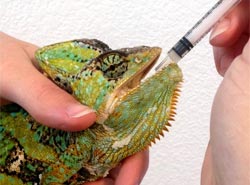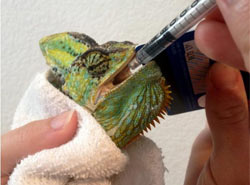Follow along with the video below to see how to install our site as a web app on your home screen.
Note: This feature may not be available in some browsers.
You should upgrade or use an alternative browser.
Veterinary Care

Having an experienced reptile veterinarian is critical to treating a sick chameleon. Regular vets may not have the experience or interest in exotic animals like chameleons and may not know enough about them to offer much help. That being said, many veterinarians are open to learning more about reptiles as exotic pets are becoming more common. Regular veterinarians also can consult with colleagues that specialize in reptiles in order to properly diagnose a chameleon after simple diagnostic tests like a fecal or blood work are performed. The cost to treat health problems vary depending on the illness and your particular vet, but could easily cost several hundred dollars or more. Remember this when purchasing a chameleon: don't buy the pet if you can't afford the vet. Certainly having proper husbandry from the beginning reduces the chances of future vet visits.
Check here to find a qualified reptile veterinarian in your area: www.arav.org.
There may be other veterinarians in your community with reptile experience so call around if needed. University veterinary teaching hospitals are also another option for medical care. Readers may want to review the following link for member recommended vets: member vet recommendations.


Most take home medications are meant to be given orally (by mouth) and giving this can be challenging and potentially stressful to both the chameleon and the owner. The easiest way to give an oral medication to your chameleon is to inject the proper amount of medicine into a feeder insect and then feed it to your chameleon immediately. This eliminates the need to hold your chameleon, force its mouth open and cause undo stress on a sickly animal. However this only works if the chameleon is hungry and accepts the insect right away. Medications hidden in food may have a delayed absorption and/or degrade before being eaten and utilized if not eaten immediately.
In the case of stubborn or non feeding chameleons gentle restraint is sometimes needed. Wrapping the chameleon loosely in a towel will stop the struggling and fighting. In many cases gently rubbing the nose or placing your fingers over the nostrils will elicit an open mouth response and the medications can then be administered into the back of the mouth. If that doesn’t work gently slide a credit card, soft spatula or other thin pliable utensil between the jaws until they open up enough to insert the syringe and administer the medication. Be careful not to injure sensitive lips and teeth when doing this. After dosing, wait for your chameleon to close its mouth before letting them go. This will allow the medications to stay in the mouth, swallowed and not be expelled or spitted out on release. Hold your chameleon with the head tilted up higher than the rest of the body to help them swallow the medication.
Make sure you finish the medications completely as prescribed even if the symptoms seem to improve before the medication is finished. Always verify that you have the right amount of the medication in the syringe or dropper before you give it to your chameleon. Some medications have serious side effects if they are accidentally overdosed. The amount of the medication to be given is written on the bottle and if you have any questions about the dosage do not hesitate to call the veterinarian for further explanations. Remember to keep all syringes and medications up and away from children and other pets and dispose of them properly once the course is complete.
Injectable medications are sometimes sent home for the owner to administer. These are more difficult to give and you should ask your vet to demonstrate how and where they are given before going home. These medications should be given in the muscle in the top part of the legs. Rotate which leg gets used so the muscles don’t become too sore from multiple injections. Having a second person and/or wrapping the chameleon in a towel will help restrain and immobilize the limb for safe injection. Some medications do sting when injected so be careful of this reflex.
Make sure you finish the medications completely as prescribed even if the symptoms seem to improve before the medication is finished. Always verify you have the right amount of the medication in the syringe or before you inject it into to your chameleon. Some medications have serious side effects if they are accidentally overdosed. The amount of the medication to be given is written on the bottle and if you have any questions about the dosage do not hesitate to call the veterinarian for further explanations. Remember to keep all syringes and medications up and away from children and other pets and dispose of them properly once the course is complete.

Most medications have predictable side effects and these should be taken into account when given to a chameleon. The following drugs are more commonly given to reptiles but always discuss the medications with your veterinarian before giving them to your chameleon. Any questions you have when you get home can certainly be directed to the veterinarian and don’t hesitate to call them. Use any medications as directed on the label.
Albon (Sulfadimethoxine): Albon (Sulfadimethoxine): An oral antibiotic used to treat bacterial infections and enteritis from coccidial infections. Albon can be hard on the kidneys, particularly in dehydrated or compromised animals so ensure that plenty of extra water is given daily while on the course of the medication. Loss of appetite and lethargy are also common side effects. The duration of therapy depends on the type of infection and response. Strict cage hygiene and cleanliness should accompany this medication to prevent reinfection. Never increase the dose without consulting with your vet as very serious side effects and death can occur. Ponazuril is a newer and safer drug for this type of infection but can be difficult to obtain. Ask your veterinarian about this option. Albon requires a prescription from your veterinarian.
Baytril (Enrofloxacin): A common antibiotic to treat some bacterial infections and it is generally prescribed as an oral medication. Injectable Baytril causes muscle necrosis and pain at the injection site so use with caution. Baytril can be hard on the kidneys, particularly in dehydrated or compromised animals so ensure that plenty of extra water is given daily while on the course of the medication. Sometimes animals have a small loss of appetite while on this medication. Never increase the dose without consulting with your vet as serious problems like vomiting and diarrhea may occur. Baytril requires a prescription from your veterinarian.
Ceftaz / Tazicef (Ceftazidime): An injectable broad spectrum antibiotic commonly given for bacterial infections. This medication is often prescribed to be given once every three days. This medication should be stored in the freezer and the individual dose should be thawed 15 minutes before administration. Use a fresh needle and syringe for every injection. Loss of appetite and lethargy are possible but generally this medication has few side effects. Stinging and bruising can occur at the injection site. Ceftazidime requires a prescription from your veterinarian.
Flagyl (Metronidazole): An oral antibiotic and antiprotozoal medication used to treat anaerobic infections and protozoan parasites. Flagyl can easily be overdosed and serious side effects (seizures, vomiting, watery or bloody diarrhea) and death can occur. Do not give this medication in larger amounts or for longer than recommended by the veterinarian. Flagyl requires a prescription from your veterinarian.
Ivomec (Ivermectin): A parasiticide that is used to treat some internal and external parasites. The medication is given orally or as an injectable depending on formulation. Stinging and swelling can occur at the injection site. Consult your veterinarian for appropriate dose and administration.
Metacam (Meloxicam): An oral Non-Steroidal Anti-Inflammatory Drug (NSAID) used to treat pain and inflammation. Metacam can be hard on the kidneys, particularly in dehydrated or compromised animals so ensure that plenty of extra water is given daily while on the course of the medication. Never increase the dose without consulting with your vet as serious problems like nausea, vomiting and kidney damage may occur. Metacam requires a prescription from your veterinarian.
Panacur (Fenbendazole): An oral broad spectrum parasiticide used to treat some intestinal parasites. Panacur can be hard on the kidneys, particularly in dehydrated or compromised animals so ensure that plenty of extra water is given daily while on the course of the medication. Loss of appetite is not uncommon but usually returns within a day or two of the dose being given. Generally doses are given at long or intermittent intervals to ensure the life cycle of the particular parasite is terminated. Good cage hygiene and cleanliness should accompany this medication to prevent reinfection. Consult your veterinarian for appropriate dose and administration.
Ponazuril: An oral anti-protozoal medication used to treat coccidial infections. This medication has fewer side effects than Albon for this type of infection, however it can be more difficult to acquire in the correct formulation. The commonly sold forumlation for horses is far too concentrated for a small reptile. This is a newer medication for small animals so side effects have not been fully evaluated, but generally this medication has few documented side effects. Ponazuril requires a prescription from your veterinarian.
